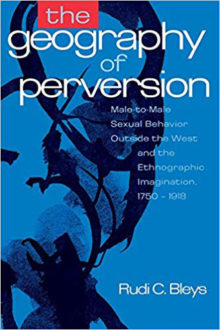 Geography of Perversion:
Male-To-Male Sexual Behavior Outside the West and the Ethnographic Imagination, 1750–1918
Geography of Perversion:
Male-To-Male Sexual Behavior Outside the West and the Ethnographic Imagination, 1750–1918
by Rudi C. Bleys
Published by New York University Press
Published December 01, 1995 History (anthropology/ethnography) 480 pgs. • Find on Amazon.com • WorldCat
Reviewed by Stephen O. Murray
July 28, 1996.One of the ironies of Magnus Hirschfeld’s attempt to distinguish congenital inverts from “situational” dabblers or, in neo-Freudian terms, “real homosexuals” from “psuedo-homosexuals,” is that at least some of the real ones kept themselves from acting on their desires (“natures”) while the fake ones invariably engaged in homosexual behavior.
Although there is much in Rudi Bleys’ Geography of Perversion that I find lacking in historicist attempt to recapture how earlier people thought, I do think he is right to see this real/situational distinction being applied to “primitive” naturvölken.
I wonder why German romanticism (generally considered the root of Boasian inquiry, and, thereby of American anthropology) is missing in action? And why the Enlightenment is so central—the first of the two post-Enlightenment periods is Darwinian, and both are preoccupied with a biology that I do not think fit the biology of their time (in which Lamarck loomed large).
He casually uses “catamite” without seeming to know of a sodomite/catamite contrast (which is even less visible in Bruce Smith’s fascinating book). And I’d be more impressed by the scope of his scholarship (which appears stupendous) if I did not suspect that he’s never seen some of what he cites (treating George Psalmanazar as a native Formosan even though he cites an article about the Psalmanazar hoax especially struck me, and I wonder if he saw my mamlûk chapter; he seems to have plundered Karsch-Haack references, which I know would not be easy given that they are incomplete and often not quite right).
Still, he stresses that this body of “literature” affected European conceptions, not just was (mis-) shaped by it. And he found some work I didn’t know about (which should gladden my heart, but sometimes instead wearies me, especially when the referenced works are in German). And he is unable entirely to uphold creationist doctrine and bracket any relation between representation and reality. There is nothing about the contexts of the fieldwork, and next to nothing about the intellectual context of European anthropology (does he mention the monogenist/polygenist debates?). He mentions concerns about degeneration but not the earlier view that the New World necessarily produced degenerates (not just the indigenous peoples but Europeans necessarily rotting here).
And it is unmistakable in his book (in contrast to Weeks’ obfuscations) that the “homosexual” created in 19th-century discourse was gender deviant, not defined by sexual object choice (there would have been no need for pseudo-homosexuals if object relations were defining).
So, Geography of Perversion is a mixed bag: often irritating, especially in oversimplifying a few monolithic zeitgeists and failing to attend to national traditions but valuable. It is well worth a close reading (one that has taken many months).
©28 July 1996, Stephen O. Murray

